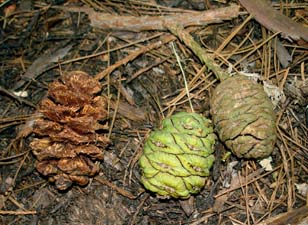Fallen green cones of the Giant Sequoia
Sequoiadendron giganteum

August 26, 2012
Tuolumne Grove of Giant Sequoias
Gusty winds recently caused many green giant sequoia cones to fall to the ground in the Tuolumne Grove and I noticed a Douglas squirrel carrying one away in its mouth.
In a few weeks, these fallen cones will have dried and opened their scales to release the 200 or so seeds contained within. The released seeds can only successfully germinate and thrive where they find bare mineral soil, ample sunlight, and ample soil moisture. Fire helps create the first two conditions by burning away the underbrush. Soil moisture is dependent on local topography and the total amount of available ground water coming from rain and snow annually. Springtime is the optimum season for seed germination.
Many people believe that seed release from giant sequoias can only occur after fire heats the cones. However, seeds can also be released by two other mechanisms: Physical shaking and breakage of branches or cone stems in high winds; and by the actions of certain animals.
The Douglas squirrel (Tamlasciurus douglasi), also known as the Chickaree, eats the cones of pines and firs, but it prefers the fleshy scales of giant sequoia cones. Though a few seeds are eaten by the squirrel, most fall to the ground in this process. The squirrel may indirectly help in seed dispersal far from the tree, if the green cone it has carried to its nest later dries out and drops some of its seeds. However, the primary means of seed dispersal is by wind from dried cones which are still on the tree after some mechanism has cut off its nourishing connections with the main tree. Wind-borne seeds may travel about 600 feet from the parent tree.
A small long horned beetle (Phymatodes nitidus) indirectly helps release giant sequoia seeds. The larvae of this beetle bore into the central axis of the cone, severing the cone's water supply. The cone dries, opens its scales, and releases its seeds.
|
September 15, 2012
|
Last updated: September 16, 2012
